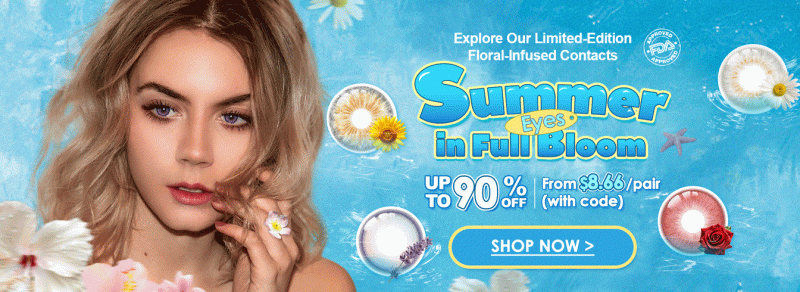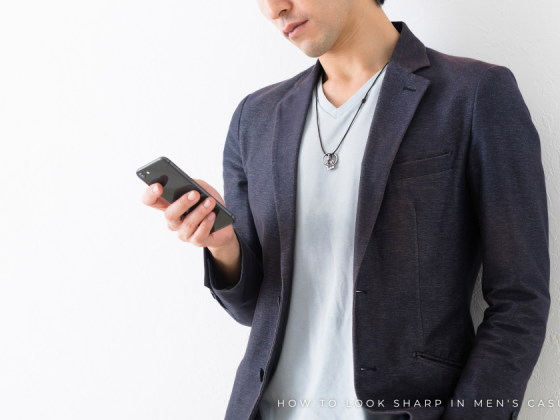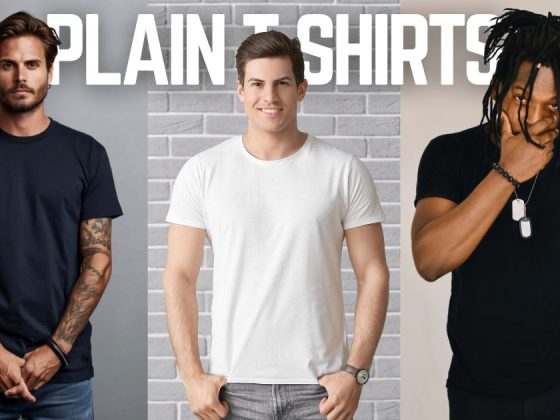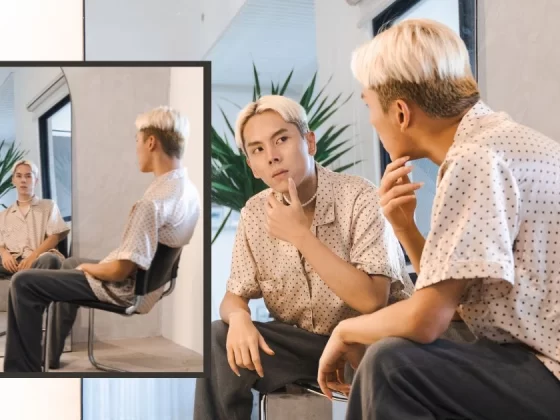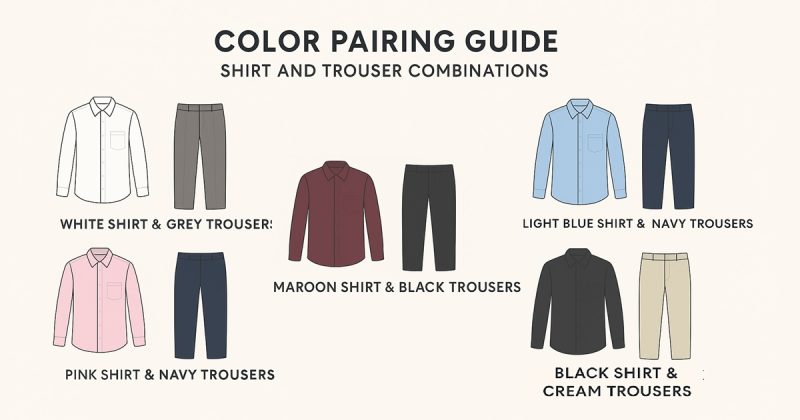
When it comes to men’s fashion, few things are as timeless and essential as the formal shirt. It’s more than just an item of clothing—it’s a wardrobe foundation, a confidence booster, and in many cases, the very first impression you make in professional and social settings. From corporate boardrooms and business lunches to weddings, interviews, and formal dinners, the right shirt color can make all the difference in how you are perceived.
But let’s be honest—buying formal shirts isn’t always as straightforward as it seems. Many men stick to safe choices like black, white, and grey because they’re universally accepted, versatile, and “mistake-proof.” While these classics will always have their place, the fashion scene has shifted in recent years. Modern menswear is more expressive, and men are increasingly experimenting with color, pattern, and subtle details to bring fresh energy to their formal wardrobes.
In this comprehensive guide, we’ll explore the best colors to go for when buying formal shirts in 2025, how to combine them with trousers, and how to wear them with confidence. We’ll also cover style updates, practical pairing tips, and the psychology of colors—so you’ll not only look sharp but also feel completely in control of your style game.
Why Shirt Colors Matter More Than You Think
Colors are powerful—they influence perception, mood, and even how others respond to you. For example, studies have shown that wearing blue or white in interviews increases the perception of trustworthiness and professionalism, while bolder tones like burgundy or deep green can project confidence and individuality in networking events.
The right color:
-
Boosts confidence – You feel more polished and put together.
-
Improves impressions – Colors influence how colleagues, clients, or peers perceive you.
-
Expands versatility – More options allow you to dress appropriately for different occasions without looking repetitive.
In other words, choosing the right shirt color isn’t just about fashion—it’s a tool for communication.
Solid Colors: The Timeless Foundation
If there’s one rule of thumb in building a formal wardrobe, it’s this: start with solid colors. Solid shirts are versatile, universally accepted in professional settings, and easier to pair with suits, ties, and trousers. They create a clean base that lets accessories, jackets, or even your personality shine without looking overdone. Every man’s wardrobe should begin here before exploring patterns or bold styles. Here are the must-haves for 2025:
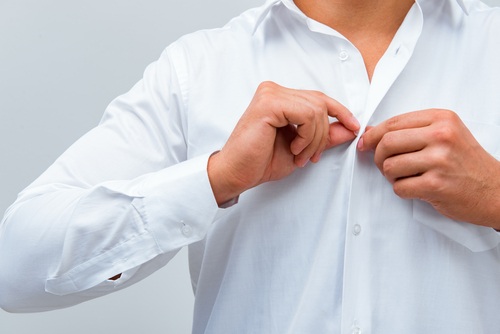
1. Crisp White – The Irreplaceable Classic
-
Works for every occasion—board meetings, weddings, interviews, or even solemn events like funerals.
-
Pairs effortlessly with any trouser or suit color, making it the ultimate wardrobe safety net.
-
Adds a fresh, clean, and authoritative look that never goes out of fashion.
Pro Tip: Invest in at least two to three high-quality white shirts. Go for breathable fabrics like Egyptian cotton or fine poplin with a slight sheen, as these hold their structure longer and resist looking worn out.
2. Shades of Blue – The New Neutral
-
Light blue shirts are second only to white in terms of versatility, making them a go-to for daily wear.
-
Navy blue or French blue adds richness and modern appeal—especially under a grey suit.
-
Works exceptionally well with grey, navy, or beige trousers for a polished look.
Why Blue? Blue subconsciously communicates trust, calmness, and approachability, making it perfect for offices, presentations, and client-facing roles. A must-have if you want to look approachable yet professional.
3. Black – The Bold Statement
-
Not always the safest for interviews (can seem too stark or intimidating), but excellent for evening events, formal dinners, and networking parties.
-
Works best with black or charcoal trousers for a sleek monochrome look.
-
Add a patterned or textured tie to break up the flatness and inject personality.
Style Note: Avoid wearing black in overly bright or hot settings, as it absorbs heat and can appear harsh during the day.
4. Soft Pastels – Subtle but Stylish
-
Colors like lavender, mint green, and light pink are no longer risky—they’ve found their place in modern formal wardrobes.
-
They’re subtle enough for the office yet bring a fresh, youthful, and approachable vibe.
-
Pair light pink with navy trousers, or lavender with charcoal grey, for a confident but understated look.
Extra Tip: Pastels work best in spring and summer but can be layered under darker blazers in autumn for year-round versatility.
5. Earth Tones and Deep Colors – For Confident Dressers
-
Maroon, olive, teal, and burgundy are trending in 2025, offering a refined alternative to neutrals.
-
They add richness and individuality without appearing flashy, striking the perfect balance between bold and professional.
-
Work best in solid form with neutral trousers (grey, beige, or black) to keep the outfit grounded.
Style Insight: Earth tones work especially well for men with medium to darker skin tones, as they enhance natural warmth, but anyone can wear them with the right balance.
When Buying Formal Shirts Based on Skin Tone
Not every color flatters everyone equally. While some shades are universally versatile (like white or light blue), others shine more when matched with your complexion. Here’s a simple guide to help:
1. Fair Skin Tones
-
Best picks: Light blue, soft pink, lavender, and crisp white—these create a contrast without washing you out.
-
Avoid: Beige or pale yellows, as they can make you look dull or washed out.
-
Pro Tip: If you’re fair and want to wear darker tones (like navy or burgundy), balance them with lighter trousers or accessories.
2. Medium / Olive Skin Tones
-
Best picks: Earth tones (olive, teal, maroon) look especially good here. Pastels like mint or lavender also pop beautifully.
-
Avoid: Colors too close to your skin tone—like camel or tan—which may blend too much.
-
Pro Tip: Experiment with richer shades like French blue or burgundy for standout looks.
3. Dark / Deep Skin Tones
-
Best picks: Bold, rich colors—royal blue, white, mustard, deep green, and burgundy—contrast strikingly against darker complexions.
-
Avoid: Very dark shades like black or deep brown worn head-to-toe, which can flatten the overall look.
Pro Tip: Light shirts (like pastel pinks or crisp white) create an elegant contrast that always works.
Choosing Shirt Colors Based on Season
Your shirt choices don’t just depend on skin tone—they also shift with the season. Here’s how to adapt while staying stylish year-round:
Spring
-
Best colors: Pastels (lavender, mint, light blue, and blush pink).
-
Why: Fresh, soft colors echo the season and bring vibrancy without being overpowering.
-
Perfect pairing: Light blue shirt with beige trousers.
Summer
-
Best colors: Whites, sky blues, soft greys, and pale pinks—all breathable and cooling.
-
Why: Light shades keep you looking sharp while reflecting heat.
-
Perfect pairing: Crisp white shirt with navy trousers for a classic summer-ready look.
Autumn
-
Best colors: Earth tones like olive, maroon, burnt orange, and deep teal.
-
Why: These shades echo the season’s warmth while staying professional.
-
Perfect pairing: Olive green shirt with charcoal trousers for a modern autumn look.
Winter
-
Best colors: Bold and deep tones—burgundy, navy, charcoal, and black.
-
Why: Stronger shades match the heavier textures (like wool suits) often worn in colder months.
-
Perfect pairing: Burgundy shirt with black trousers for evening events.
Elegant Stripes: A Staple of Businesswear
While solids are essential, striped shirts bring dimension to your wardrobe. The key is choosing the right style of stripes.
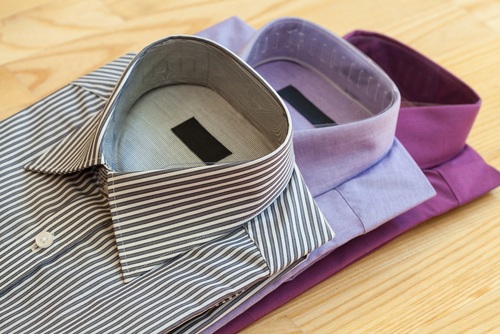
-
Thin pinstripes – Ideal for formal office settings; pair with solid suits.
-
Bengal stripes (medium-width) – Stylish yet professional, works well under blazers.
-
Avoid bold, thick stripes – These lean more toward casual or fashion-forward looks.
Best color options for striped shirts in 2025:
-
Blue stripes on white (the most classic).
-
Grey stripes on white for a modern tone.
-
Light pastel stripes (lavender, pink, or green) for a subtle statement.
Pro Tip: Keep your tie either solid or with minimal patterns when wearing stripes to avoid clashing.
Checked Shirts: A Balancing Act
Checks are often seen as more casual, but when chosen carefully, they can still work in formal settings.
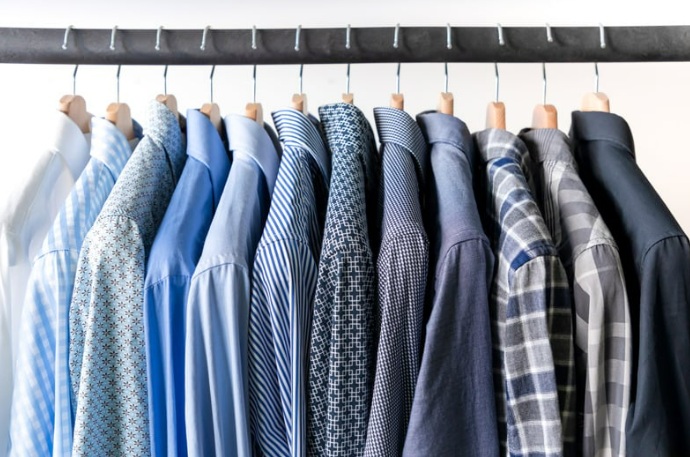
How to Wear Checks Formally:
-
Stick to small, subtle checks (micro-checks, gingham, or tattersall).
-
Keep the color base light (e.g., light blue checks on white).
-
Pair with solid trousers to keep the balance formal.
Best checked shirt colors in 2025:
-
Navy or light blue checks on white.
-
Grey checks with subtle accents.
-
Burgundy micro-checks for a polished but unique touch.
Smart Color Combinations for Formal Shirts
The magic of looking sharp doesn’t just come from the shirt itself—it’s about how you combine it with trousers, ties, and blazers. Let’s look at some effective combinations:
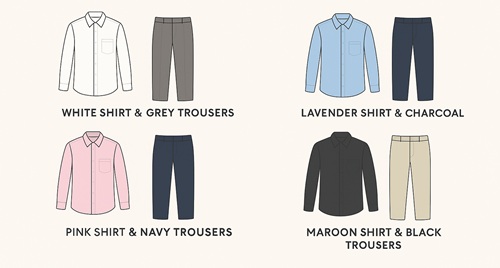
With Solids
-
White shirt + Grey trousers – Timeless, sophisticated, and safe.
-
Light blue shirt + Navy trousers – A classic office-ready pairing.
-
Navy shirt + Beige trousers – Balanced and modern.
-
Lavender shirt + Charcoal trousers – Subtle yet stylish.
-
Pink shirt + Navy trousers – Confident, fresh, and fashionable.
With Patterns
When mixing patterns, the rule is simple: balance.
-
Patterned shirt + Solid trousers – Safer and more elegant.
-
Solid shirt + Patterned trousers – Works if the trousers are muted (e.g., grey checks).
-
Pattern-on-pattern – Best avoided unless you’re highly confident with styling.
Examples:
-
Blue pinstripe shirt + Grey solid trousers.
-
White solid shirt + Black-and-grey checked trousers.
-
Burgundy solid shirt + Subtle plaid trousers.
Pro Styling Tips for Formal Shirts in 2025
-
Fabric Matters: Choose breathable fabrics like cotton blends or performance fabrics with wrinkle resistance—perfect for long office hours.
-
Fit is King: Slim or tailored fits look sharper than loose, baggy shirts.
-
Collar Styles: Spread collars pair well with ties; button-down collars can be dressed down slightly.
-
Accessories: Match ties, pocket squares, and cufflinks with the shirt’s color scheme for polish.
-
Layering: Blazers or vests in neutral shades make colorful shirts more versatile.
Mistakes to Avoid When Choosing Shirt Colors
-
Overly loud shades like neon or too-bright colors for formal settings.
-
Wearing black in the heat of summer—opt for lighter shades instead.
-
Mixing too many patterns—stripes with bold checks create visual chaos.
-
Ignoring skin tone—pick shades that complement your complexion.
-
Wearing the same two colors repeatedly—variety signals sophistication.
Updated Trends for 2025
-
Sustainable fabrics: Organic cotton, bamboo blends, and recycled fibers are gaining popularity.
-
Earth-inspired palettes: Sage green, dusty blue, and clay tones are trending this year.
-
Performance dress shirts: Wrinkle-free, moisture-wicking shirts that look crisp all day are in demand.
-
Mix of formal and casual: Offices embracing “business-casual” allow checked and pastel shirts more freely.
Final Thoughts
Building a collection of formal shirts is about more than just looking professional—it’s about crafting an image that reflects confidence, individuality, and adaptability. While white, blue, and grey remain timeless staples, experimenting with pastels, earth tones, and subtle patterns in 2025 allows you to stand out without sacrificing elegance.
The key is balance: start with a solid foundation of classic colors, then expand into stripes, checks, and new shades that match your personality and lifestyle. By paying attention to fabric, fit, and pairing, you’ll always project sophistication—whether you’re leading a meeting, attending a wedding, or stepping into an interview.
Fashion is evolving, and your wardrobe should too. By embracing more colors in your formal shirt collection, you’ll not only look modern but also feel more confident and versatile. After all, style isn’t just about clothes—it’s about how you carry yourself, and the right shirt color can make all the difference.

